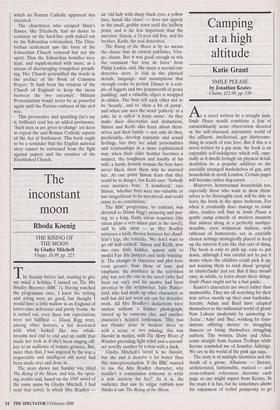The inconstant moon
Rhoda Koenig
THE RISING OF THE MOON by Gladys Mitchell Virago, £6.99, pp. 223 The Sunday before last, wanting to give my mind a holiday, I turned on The Mrs Bradley Mysteries (BBC 1). Having watched the programme once, I knew the writing and acting were no good, but thought I would have a little wallow in an England of lower-class deference and pretty frocks. As it turned out, even these low expectations were not fulfilled — Diana Rigg wore, among other horrors, a hat decorated with what looked like two whisk- brooms tied end to end and an outfit that made her look as if she's been singing off- key to an audience of tomato-growers. But, more than that, I was angered by the way a respectable and intelligent old novel had been made over and done in.
The story shown last Sunday was titled The Rising of the Moon, and was, the open- ing credits said, based on the 1945 novel of the same name by Gladys Mitchell. I had read that novel, in which Mrs Bradley — an 'old lady with sharp black eyes, a yellow face, hands like claws' — does not appear in the small, grubby town until the halfway point, and is far less important than the narrator, Simon, a 13-year-old boy, and his brother, Keith, the real detectives.
The Rising of the Moon is by no means the classic that its current publisher, Vira- go, claims. But it was good enough to win the comment ter tour de force' from Philip Larkin, and, like many a second-rate detective story, is rich in the physical details, language, and assumptions that strongly evoke its period. Dinner is 'a cou- ple of faggots and two pennyworth of pease pudding', and a valuable object is wrapped in oilskin. The boys tell each other not to be 'beastly', and to 'show a bit of gump', and when one uses the word 'puberty' in a joke, he is called 'a lousy swine'. As they make their discoveries and deductions, Simon and Keith also learn about them- selves and their family — not only do they, predictably, develop romantic and sexual feelings, but they see adult personalities and relationships in a more sophisticated way: when their older brother becomes a suspect, the toughness and loyalty of his wife, a harsh, homely woman the boys have never liked, show them why he married her. At one point Simon fears that they could be in danger, but Keith says, 'Nobody ever murders boys.' 1 wondered,' says Simon, 'whether boys were too valuable or too insignificant to be murdered, and could come to no conclusions.'
The BBC programme, by contrast, was devoted to Diana Rigg's prancing and pos- ing, to a long, flashy circus sequence (the circus plays a very minor part in the novel), and to silly smut — as Mrs Bradley retrieves a knife thrown between her chauf- feur's legs, she remarks, 'We don't want to go off half-cocked.' Simon and Keith, now two cute little kiddies, appear only to model Fair Isle jumpers and smile winning- ly. The changes in character and plot were even greater than those of tone and emphasis: the murderer in the television play was not the one in the novel (who had been cut out), and his motive had been invented by the scriptwriter, Julie Rutter- ford, who had made up other characters as well but did not seem cut out for detective work. All Mrs Bradley's deductions were useless without a hidden photograph, turned up by someone else, and another character's belated confession. This was not Hamlet done in modern dress or with a scene or two missing; this was Hamlet in motley, with The Merty Wives of Windsor providing light relief and a second- act novelty number by a man with a duck.
Gladys Mitchell's novel is no Hamlet, but she and it deserve a lot better than this misrepresentation. lithe BBC wanted to use the Mrs Bradley character, why couldn't it commission someone to write a new mystery for her? As it is, the audience that saw its vulgar rubbish now thinks it saw The Rising of the Moon.


























































 Previous page
Previous page